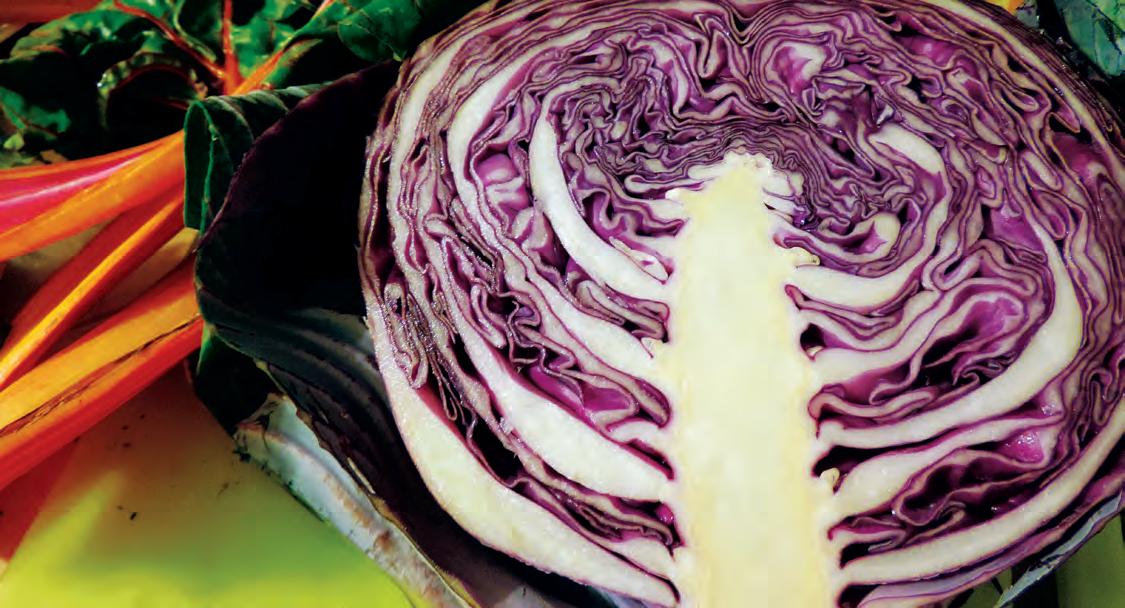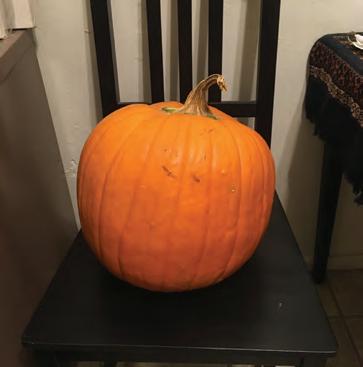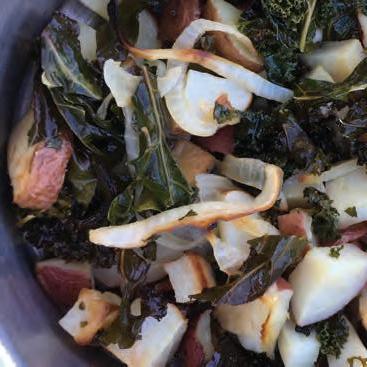
7 minute read
THE BORROWED GARDEN by Abigail R. Dockter
The Borrowed Garden Story and photos by Abigail R. Dockter
This spring, I did not have a garden. My work often takes me out of town, and the only plants that tolerate my absence are three small agaves in pots on the back porch and one adorably ugly Dorstenia in the front window. As the impacts of COVID-19 ballooned across the U.S. this past spring (especially in Arizona, where I live) and as hoarding impulses ran amok and food supply and distribution systems were disrupted, I rebooted my Community Supported Agriculture share. Down the street, my local Middle Eastern market did a roaring trade at three in the afternoon, the parking lot packed with new clientele. I was not a first-time CSA customer, but I had just managed to talk another friend, Sally, into splitting the cost and the bounty. Community Supported Agriculture is a subscription model in which customers buy into local farms and are repaid in produce — vegetables, in my case, although CSAs also exist for meat, milk, honey, and other products. The Tucson CSA benefits from a year-round growing season and a dense urban area of potential customers. But with farming, you always take what you get, and Sally was skeptical at first. She worried about the cost, the limitations of eating only what is harvested locally each week, and whether she might end up with too much food or too little. I’m a worrier too, but also, lately, a CSA evangelist. During the pandemic, it has changed my life. Aside from inventing infinite variations on the peanut butter tortilla, I have never been an inspired or talented cook. But the CSA reversed the standard culinary logic in a way that made sense to me: Instead of choosing recipes and then getting ingredients, I was given ingredients and went in search of recipes. I polled my friends and relatives — “What the heck do you do with collard greens?” — and trawled the internet for advice about rutabagas. I developed new instincts for cooking and combining foods, a creative intuition I’d never exercised before. I understood for the first time how those instincts are slightly different for different people, depending on the culinary traditions you draw from and the ways you’ve departed from what your family fed you as a child. Sally turned out to love the CSA as much as I did, though her experience was greatly influenced by the circumstances of the pandemic. “I hardly ever go to the grocery store!” she told me, delighted, five weeks in. The nutritious greens of spring — beet tops, curly kale, amaranth, and purple cabbage — fortified us. Tucson’s CSA is running at capacity with a full waitlist this year, just as the heritage seed provider Native Seed/SEARCH asked their customers to limit the number of seed packets they buy at one time, making sure there are enough for the Native American communities the organization serves. This spring, new gardens sprang up. Seeds sold out; chickens sold out. Suddenly, the roads our food took to get to us seemed long, with too many opportunities for something to go wrong along the way. Outside, the heat grew in intensity. The radio was terrifying, and social media felt absurdly loud in the quiet rooms where we suddenly spent all our time, alone, trying not to contemplate our own vulnerabilities or those of the people we love. I nursed my disappointments over how I thought my life this year would go. Resilience, the bounceback, the weathering of crisis, is on a growing list of words I believe in 16
Advertisement
wholeheartedly but also treat with suspicion. Resilience is a quality that people develop of necessity rather than by choice — it shines when something bad has happened to you. And especially with regards to COVID-19, an ounce of prevention may be worth a pound of resilience. But the need for resilience can also bode well, like local food producers and seed companies reeling from the sudden spike in interest in heritage seeds and sustainable meat. How to respond to the latest wild fluctuation in our food system is up for discussion, but the best-case scenario would see more people involved in smallscale, sustainable agriculture, both on the production side and as reliable customers. When the Idaho organic beef operation Alderspring Ranch was overwhelmed with orders, Caryl Elzinga wrote in a Facebook post, “Frankly, this country needs more Alderspring Ranches rather than bigger Alderspring Ranches. Even more, this country needs a smaller-scale decentralized processing system because shutting down one of our giant processing plants, even for a few days, echoes through the entire supply chain. … People are starting to see that and thinking about their food sources in ways they never have.” From Elzinga’s perspective, for a rancher concerned with long-term soil health on land where they plan to graze cattle well into the future, producing a lot more beef to meet this sudden demand is not being resilient — it’s unsustainable. But if other producers can respond to the swelling appreciation for places like Alderspring, then the entire food system becomes more capable of necessary change. In many ways, this perfect storm of the pandemic and the utter ineptitude of our institutions feels familiar to me, expected. But right now cynicism is not my interest, because what I want to know is how we live through this moment. I want to know where the action is and what models we can follow to weather this crisis and the ones to come. I find there are people with answers, that the groundwork is already in place. The Tucson Food Share, for instance, is an entirely volunteer-run operation that stepped up immediately this year to ensure everyone had the resources they needed. Community gardens like Las Milpitas, which provides fresh food for the Community Food Bank of Southern Arizona (as well as to individuals and families), and La Siembra, a project of the Flowers and Bullets art collective that grows food on the ten acres of a disused elementary school in Midtown, are further examples of local organizations responding to the specific needs and opportunities of recipes. around them. These options are far more affordable than a CSA share, but for me, for the moment, the CSA model is the one that makes most sense, and I am glad it was here when I needed it. I want to make sure all these options continue to be here when we need them—because inevitably, we will need them again. The CSA occasionally includes local desert foods and Native American crops, such as amaranth greens and nopales (prickly pear cactus pads). These are the foods that have been growing here in relation with humans for thousands of years, plants well-adapted to harvesting and people well-adapted to the needs of particular plants. Many of these foods are not grocery store fare, but once introduced, I looked forward to getting them. I chewed the fresh, crisp amaranth stems down like a rabbit as I cooked the leaves. I filled squash blossoms with cornmeal and baked them per the sipongviki recipe in Hopi Cookery. Those sturdy agaves on my porch could be eaten if I cut off their spines and roasted the hearts, but right now I prefer watching them grow. They’re the only vegetation that really enjoys this kind of heat. The evening of picking up the CSA has become the highlight of my week: meeting Sally on her porch, chatting as she divvies up vegetables, washes and rinses them, and pours the water on her orange tree. Last
week, I opened the bottle of wine another friend had given me months before. I remarked on these small economies of giving and taking, and how they go unmeasured, ungrossed. To have a glass of wine six feet apart as the sun sets behind the dry hills is the bulk of my social interaction these days, and I know the vegetables are not the only thing keeping us healthy. I still depend on other people’s gardens. But as scary as that dependence can feel, there are ways to turn it into connection, that taste I’ve been craving. I buy a share and I share it. One week at a time, we take the heat.












